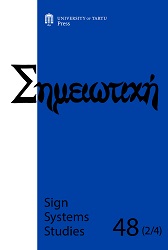What We can Learn from Semiotics, Systems Theory, and Theoretical Biology to Understand Religious Communication
What We can Learn from Semiotics, Systems Theory, and Theoretical Biology to Understand Religious Communication
Author(s): Volkhard KrechSubject(s): Semiotics / Semiology, Social Philosophy, Philosophy of Religion, Philosophy of Language, Theory of Communication
Published by: Tartu Ülikooli Kirjastus
Keywords: semiotics of religion; biosemiotics of religion; systems theory of religion; religious evolution; religious communication;
Summary/Abstract: If religion is a socio-cultural meaning system as part of the socio-cultural sphere, then how does it relate to mental, organic, and physical processes that belong to the environment of religion? The article contributes to answering this question by referring to semiotics, systems theory, and theoretical biology. The starting point is understanding religious evolution as a co-evolution to societal evolution, namely, as one of the latter’s internal differentiations. In turn, societal evolution is a co-evolution to mental, organic, and physical evolution. Th ese evolutionary spheres mutually constitute one another’s environments. The eigenstate of the socio-cultural sphere consists of language activated via communication. Language is the replicator of socio-cultural processes corresponding to the function of the genome in organic processes. The differentiation of spheres in general evolution concerns respective organic, mental, and socio-cultural substrates, while the substrate-neutral structure of the two evolutionary dimensions of organic and societal processes, including religion, is revealed as semiotic patterns that organic and societal processes have in common. Organic and religious processes of generating information are isomorphic. Th us, semiosis mediates between religious communication and its environment.
Journal: Σημειωτκή - Sign Systems Studies
- Issue Year: 48/2020
- Issue No: 2-4
- Page Range: 192-223
- Page Count: 32
- Language: English

